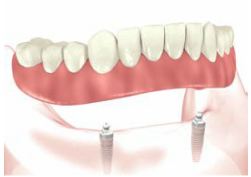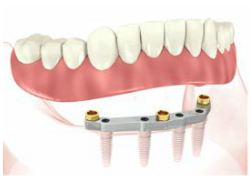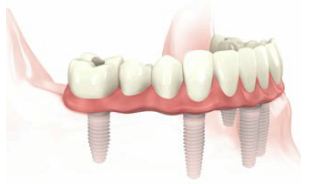Implant Retained Dentures
Have missing teeth? Attractive, healthy teeth play an important role in our general health and well-being. Contact us on (07) 3221 0677 for your missing teeth solution!
Complete Upper and Lower Implant Retained Dentures
Why old fashioned dentures are not the answer?
Unsecured dentures are a traditional solution for people who have lost all their teeth. Some patients may find that wearing unsecured dentures can be painful, inconvenient and awkward. Such dentures can make it difficult to chew a variety of foods, which can stop you from eating many of the foods you once enjoyed. Wearing dentures may also affect how you pronounce words, and therefore the way you speak.
Your dentist has the solution that is right for you.

(Strong, healthy teeth are important for health and well-being.)
A variety of modern dental implant-based tooth replacement solutions are available. Any of these solutions can dramatically improve your quality of life; such as enabling proper chewing and speaking, increasing comfort, and encouraging the consumption of a wider variety of foods. Ask your Brisbane dentists at Face Value Dental for the solution that is right for you.
Implant Retained Dentures Cost
Because of the complex nature and various options that are available is it not possible to give an accurate estimate of costs until such time as a diagnostic consultation is completed and a treatment plan is prepared.
What are the Benefits of Implant Retained Dentures?
People who have suffered with dental problems may ultimately have to consider getting dentures. While the traditional dentures that are removable have been the choice for many people, implant retained dentures are becoming the new choice.
Implant retained dentures offer a host of benefits that make it a much better choice than traditional dentures.
Dentures are simply a restoration for missing teeth. You can have a partial set or full set of dentures. They are generally made from a plastic base, with artificial teeth positioned on the frame. This is a replacement for natural teeth, not just for cosmetic reasons. Missing teeth can impact ability to speak clearly, interfere with eating, and can ultimately have negative health consequences. Dentures are used to eliminate these problems.



Another problem with missing teeth is the impact it has on bone structure. Implant retained dentures not only look natural, but it will make your smile beautiful again. It will keep your facial structure younger looking, because the teeth help hold everything in place.
Here are some of the steps you can expect in the treatment process:
Initial consultation
Before any work gets done, the dentist will review your individual case: Study medical and dental records; take x-rays; take impressions of your teeth and gums. Where necessary, you may even need to go for a CT scan. The main purpose of the initial consultation is to determine the quality and quantity of your bone as well as the prime location for placing the implants. The impressions will also be used to make models of your teeth structure upon which the dimensions of the temporary denture are based.
Procedure #1
This session generally involves making an incision in the gums and placing the implants in the jawbone. After the implant is placed into the hole (drilled in the bone), the dentist will stitch up the incision. The temporary denture is then positioned in such a way that no direct pressure is placed on the implants – a soft reline may be necessary to take the pressure off your gums.
The timing of the second procedure depends on whether the implants were placed in the upper (5-6 months later) or lower jaw (3-4 months later). This period is to allow the bone and implants to biologically ‘fuse’ together in a process known as osseointegration.
Procedure #2
Following the osseointegration process, the implant is ready for the second procedure. The dentist would confirm whether the implants have become fused with the bone by taking an x-ray. In this follow-up procedure, a small incision would be made in the gum to expose the tops of the implants.
Once the implants have become fused with the bone, the second procedure can be scheduled. Your dentist will confirm whether the implant is ready for the second procedure by taking an X-ray. This surgery is simpler than the first, which involves making a small incision in your gum to expose the tops (heads) of the implants.
The dentist would then place a round piece of metal, known as a collar or healing cap, on the head of each exposed implant. The collar, used to hold the gums separate from the implant head, will remain in place for 10-14 days. In the meantime, the temporary denture may be adjusted or given another reline. The healing caps will be replaced with regular abutments about two weeks after the second procedure. By now, your gums would have healed and your dentist is able to take impressions of your gum tissue and abutments. The model of your jaw and abutments is then made to fabricate the permanent denture.
Try-in and Insertion
At this final stage, usually in month 5 or 7 – depending on whether a denture needs to be made – you are ready to have the initial try-in of the new denture. Once the metal bar is placed on the abutments and fits together with the dental framework properly, the artificial teeth would be temporarily placed on the framework in wax. If everything checks out – with the whole denture tried in your mouth – the teeth would then be permanently lodged in the denture framework. Depending on the type of implant-supported denture you have selected, either the ball or bar attachments will be secured at this juncture.
You will have to return for another visit to insert the completed denture. The denture may either be snapped into the ball attachments or clipped onto the bar.
Implant Retained Dentures - Frequently Asked Questions
How long does the implant-retained denture procedure take and what does it involve?
There are different types of implant treatments with differing time frames and procedures. Generally speaking, a standard implant treatment would require two procedures: One to place the implants into the jawbone, and second, to expose the top of the implants so that the implant-supported denture may be affixed to them. The second procedure is normally performed three to six months after the first one.
It is also possible to use a one-stage procedure, in which the implants as well as supporting bar are placed in a single step. Both types of treatments enjoy a healthy success rate.
Where will the implants be placed?
The implants are usually placed in the area of the jawbone with a higher bone mass – typically at the front of your mouth. The front jaw is also preferred because it does not have many nerves or structures that may complicate the implant placement.
The time it takes to complete the treatment depends on different factors, including: Type of implant used; whether the treatment is for the upper or lower jaw; if bone grafting is required; number of implants, etc. For standard implants, the process can take anywhere between 5 months to a year or more.
Do I need a temporary denture?
The temporary denture is necessary only if you are not already wearing a complete denture for your missing teeth. As the name suggests, the temporary denture is used as a placeholder while you wait for your final implant-supported denture to be made. It also serves as a back-up prosthesis in the unlikely event the final denture is damaged.
Why should you get Implant Retained Dentures?
Implant retained dentures are more secure than traditional dentures. Removable dentures must be held in place by a bonding agent, and are traditionally known for coming loose when you eat certain foods. Implants are held in place more securely and are overall more reliable.
- Implant dentures are also more comfortable for the wearer. Most people report they don’t even feel like they have dentures in.
- Implant retained dentures also prevent the wearer from experiencing sore spots and pressure points commonly associated with removable dentures.
- When wearing implanted dentures, it prevents further bone loss that occurs from missing teeth. This also allows the facial structure to stay the same, and keeps your mouth healthier.
Contact Face Value Dental, your Brisbane dental clinic, on (07) 3221 0677 to book your consultation today!
Quick links to other treatment options to restore your smile:
Extended Opening Hours
Albert Street
| Monday | - | 8.00am - 5.00pm |
| Tuesday | - | 8.00am - 8.00pm |
| Wednesday | - | 8.00am - 5.00pm |
| Thursday | - | 8.00am - 8.00pm |
| Friday | - | 8.00am - 5.00pm |
| Saturday & Sunday | - | Closed |
| Closed on Public Holidays | ||
Health Funds
At Face Value Dental, we are committed to offering excellent dental care that is both affordable and convenient.